北师大版(2019)必修 第二册Unit 6 The admirable Lesson 1 A Medical Pioneer课件(共28张PPT)
文档属性
| 名称 | 北师大版(2019)必修 第二册Unit 6 The admirable Lesson 1 A Medical Pioneer课件(共28张PPT) |
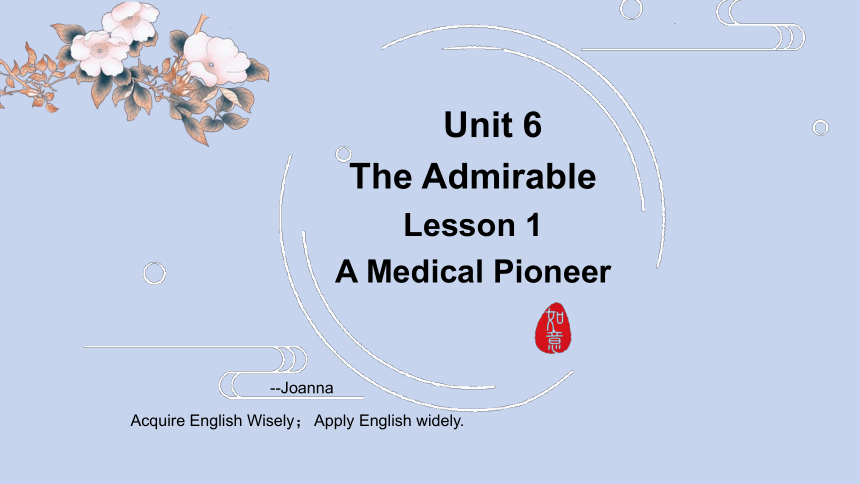
|
|
| 格式 | pptx | ||
| 文件大小 | 6.0MB | ||
| 资源类型 | 教案 | ||
| 版本资源 | 北师大版(2019) | ||
| 科目 | 英语 | ||
| 更新时间 | 2023-05-28 15:14:46 | ||
图片预览

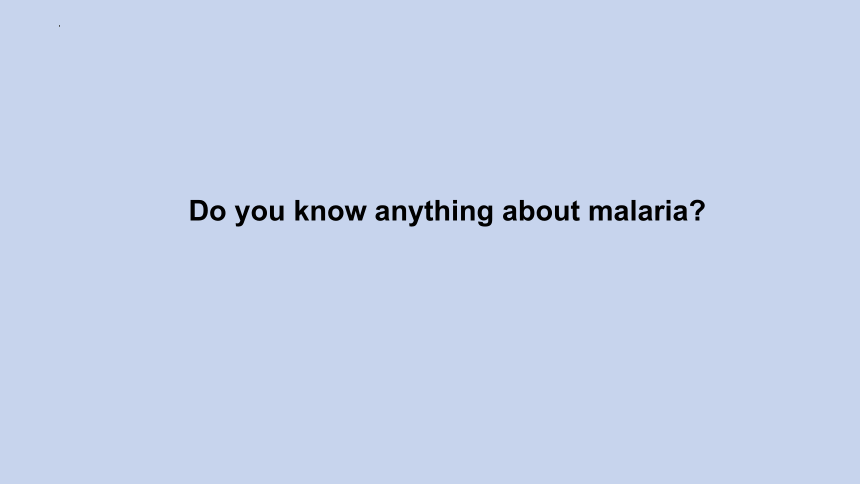
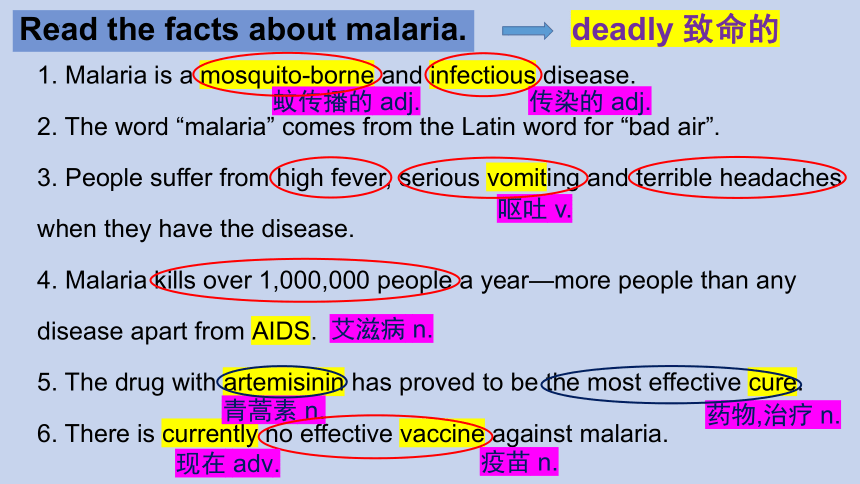
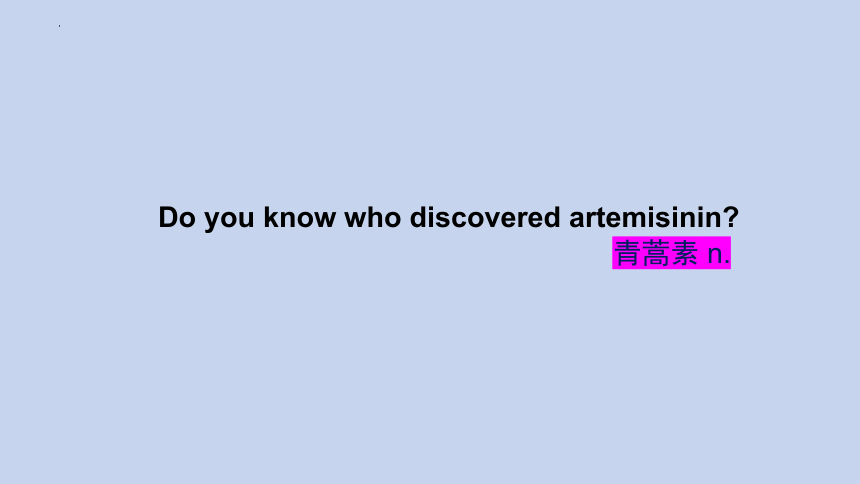
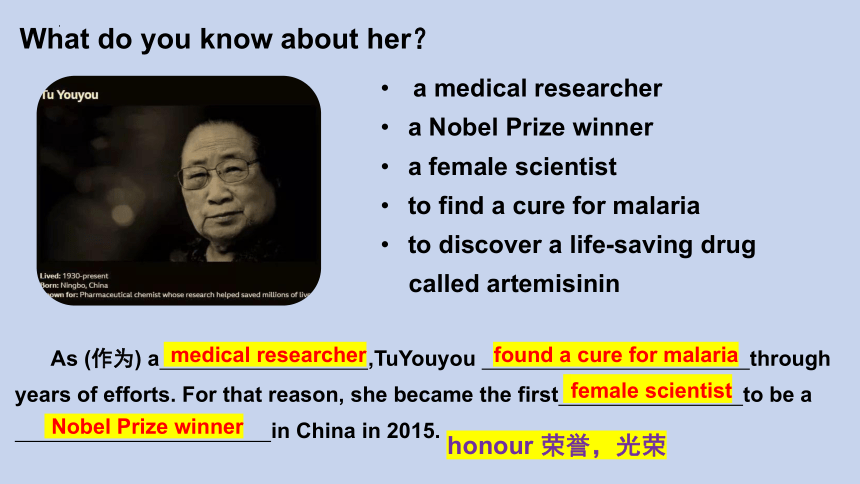
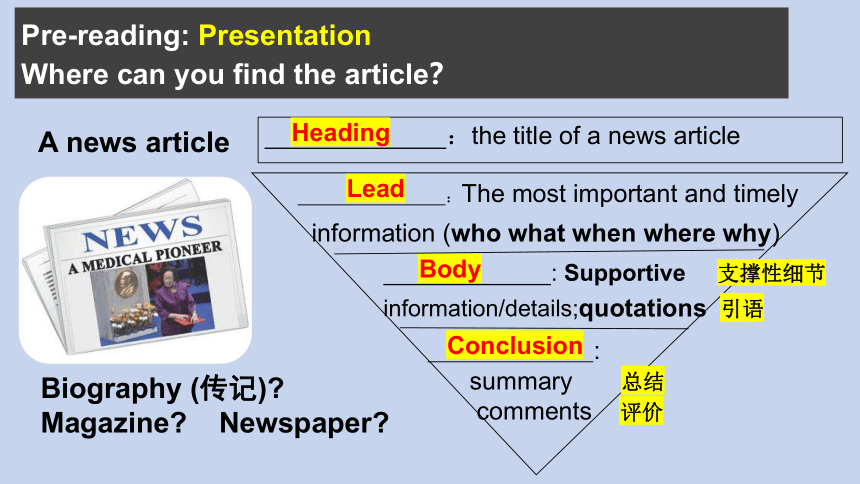
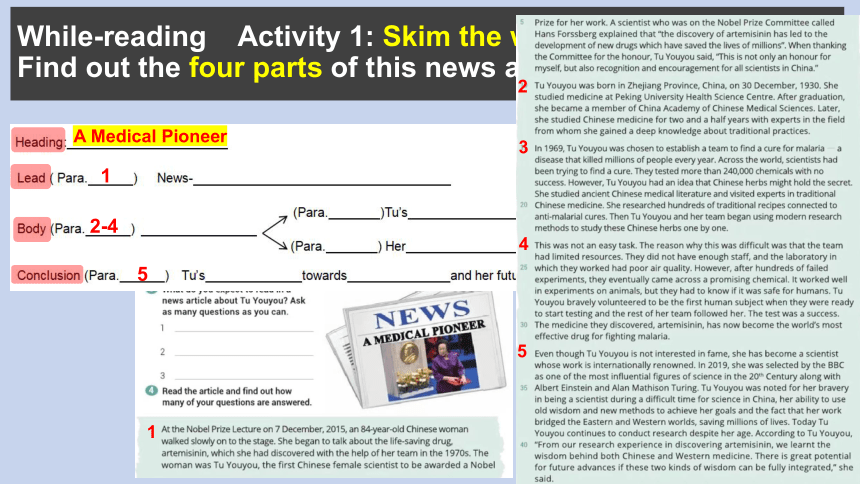
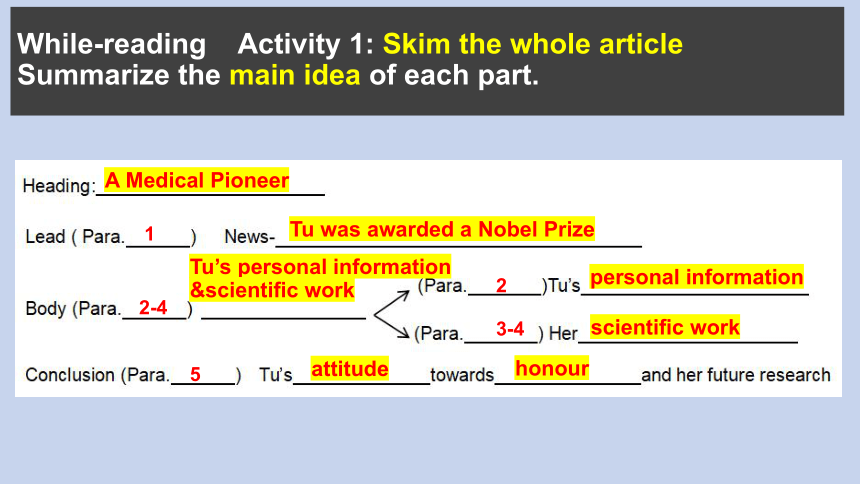
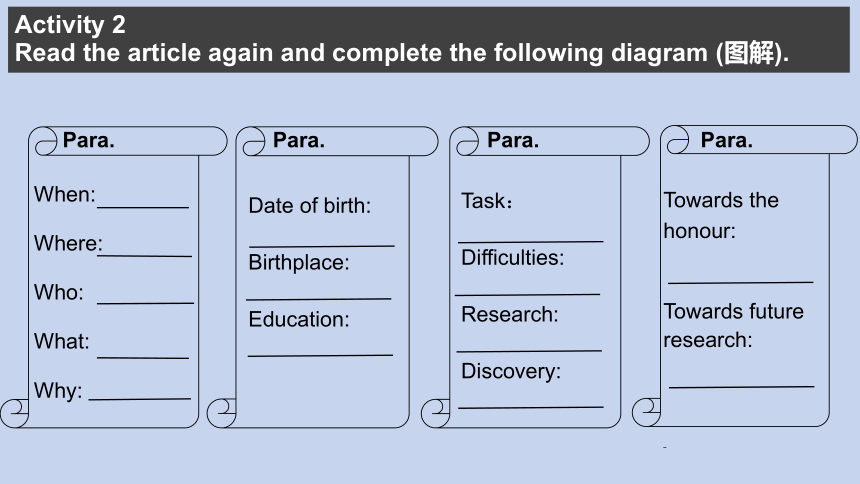
文档简介
(共28张PPT)
Unit 6
The Admirable
Lesson 1
A Medical Pioneer
--Joanna
Acquire English Wisely; Apply English widely.
Do you know anything about malaria
Read the facts about malaria.
1. Malaria is a mosquito-borne and infectious disease.
2. The word “malaria” comes from the Latin word for “bad air”.
3. People suffer from high fever, serious vomiting and terrible headaches when they have the disease.
4. Malaria kills over 1,000,000 people a year—more people than any disease apart from AIDS.
5. The drug with artemisinin has proved to be the most effective cure.
6. There is currently no effective vaccine against malaria.
传染的 adj.
艾滋病 n.
青蒿素 n.
疫苗 n.
呕吐 v.
药物,治疗 n.
deadly 致命的
蚊传播的 adj.
现在 adv.
Do you know who discovered artemisinin
青蒿素 n.
a medical researcher
a Nobel Prize winner
a female scientist
to find a cure for malaria
to discover a life-saving drug
called artemisinin
What do you know about her?
As (作为) a ,TuYouyou through years of efforts. For that reason, she became the first to be a
in China in 2015.
medical researcher
Nobel Prize winner
found a cure for malaria
female scientist
honour 荣誉,光荣
Pre-reading: Presentation
Where can you find the article?
A news article
:The most important and timely
information (who what when where why)
:the title of a news article
: Supportive 支撑性细节
information/details;quotations 引语
:
summary 总结
comments 评价
Heading
Lead
Body
Conclusion
Biography (传记)
Magazine Newspaper
While-reading Activity 1: Skim the whole article
Find out the four parts of this news article P52
1
2
3
4
5
1
2-4
5
A Medical Pioneer
While-reading Activity 1: Skim the whole article
Summarize the main idea of each part.
1
2-4
5
attitude
honour
Tu was awarded a Nobel Prize
scientific work
personal information
Tu’s personal information &scientific work
2
3-4
A Medical Pioneer
Activity 2
Read the article again and complete the following diagram (图解).
Para.
When:
Where:
Who:
What:
Why:
Para.
Para.
Para.
Date of birth:
Birthplace:
Education:
Task:
Difficulties:
Research:
Discovery:
Towards the honour:
Towards future research:
Activity 2.1 Read para.1
Find out the “5 w” information (when\where\who\what\why).
At the Nobel Prize Lecture on 7 December, 2015, an 84-year-old Chinese woman walked slowly on to the stage. She began to talk about the life-saving drug, artemisinin, which she had discovered with the help of her team in the 1970s. The woman was Tu Youyou, the first Chinese female scientist to be awarded a Nobel Prize for her work.
A scientist who was on the Nobel Prize Committee called Hans Forssberg explained that “the discovery of artemisinin has led to the development of new drugs which have saved the lives of millions”. When thanking the Committee for the honour, Tu Youyou said, “This is not only an honour for myself, but also recognition and encouragement for all scientists in China.”
where:_______________________
what:_______________________
who:________________________
why:________________________
when:_______________________
Activity 2.1 Read para.1
Find out the “5 w” information (when\where\who\what\why). P52-53
Para. 1 News-Tu won a Nobel Prize
On 7 December, 2015
At the Nobel Prize Lecture
Tu Youyou
Discovered artimisinin
Tu was awarded a Nobel Prize
Tu Youyou was born in Zhejiang Province, China, on 30 December, 1930. She studied medicine at Peking University Health Science Centre. After graduation, she became a member of China Academy of Chinese Medical Sciences. Later, she studied Chinese medicine for two and a half years with experts in the field from whom she gained a deep knowledge about traditional practices.
Activity 2.2 Read para.2
Find Tu’s personal information (birth, birthplace & education). P53
Date of birth:
Birthplace:
Education:
30 December, 1930
Zhejiang Province
Studyed medicine at Peking University
Para. 2 Tu’s personal information
Activity 2.2 Read para.2
Find Tu’s personal information. P53
In 1969, Tu Youyou was chosen to establish a team to find a cure for malaria—a disease that killed millions of people every year. Across the world, scientists had been trying to find a cure. They tested more than 240,000 chemicals with no success. However, Tu Youyou had an idea that Chinese herbs might hold the secret. She studied ancient Chinese medical literature and visited experts in traditional Chinese medicine. She researched hundreds of traditional recipes connected to anti-malarial cures. Then Tu Youyou and her team began using modern research methods to study these Chinese herbs one by one.
This was not an easy task. The reason why this was difficult was that the team had limited resources. They did not have enough staff, and the laboratory in which they worked had poor air quality. However, after hundreds of failed experiments, they eventually came across a promising chemical. It worked well in experiments on animals, but they had to know if it was safe for humans. Tu Youyou bravely volunteered to be the first human subject when they were ready to start testing and the rest of her team followed her. The test was a success.The medicine they discovered, artemisinin, has now become the world’s most effective drug for fighting malaria.
Activity 2.3 Read para.3-4
Find out Tu’s scientific work (task,dificulty,research discovery). P53
Task:________________________________________
Research:_________________________________
_________________________________
_________________________________
Discovery:________________________________
to find a cure for malaria
studied ancient Chinese medical literature
Artemisinin
Difficulties:_____________________________
_____________________________
limited resources;
studied and tested Chinese herbs
and poor air quality
Activity 2.3 Read para.3-4 Find out Tu’s scientific work. P53
Para. 3-4 Tu’s scientific work
researched hundreds of traditional recipes
not enough staff
Even though Tu Youyou is not interested in fame, she has become a scientist whose work is internationally renowned. In 2019, she was selected by the BBC as one of the most influential figures of science in the 20th Century along with Albert Einstein and Alan Mathison Turing. Tu Youyou was noted for her bravery in being a scientist during a difficult time
for science in China, her ability to use old wisdom and new methods to achieve her goals and the fact that her work bridged the Eastern and Western worlds, saving millions oflives. Today Tu Youyou continues to conduct research despite her age. According to Tu Youyou, “From our research experience in discovering artemisinin, we learnt the wisdom behind both Chinese and Western medicine. There is great potential for future advances if these two kinds of wisdom can be fully integrated,” she said.
Activity 2.4 Read Para.5
Find out Tu’s attitude P53
Towards future research:
____________________________
Towards the honour:
____________________________
Activity 2.4 Read Para.5
Find out Tu’s attitude to honour and future work P53
Para. 5 Tu’s attitude to honour
and future research
positive/optimistic
not interested in fame
Post-reading Activity 1 Read para.3 and para.4
Summarize Tu 's good qualities (using adjectives 形容词).
In 1969, Tu Youyou was chosen to establish a team to find a cure for malaria—a disease that killed millions of people every year.Across the world, scientists had been trying to find a cure. They tested more than 240,000 chemicals with no success. However, Tu Youyou had an idea that Chinese herbs might hold the secret. She studied ancient Chinese medical literature and visited experts in traditional Chinese medicine. She researched hundreds of traditional recipes connected to anti-malarial cures. Then Tu Youyou and her team began using modern research methods to study these Chinese herbs one by one. (para. 3)
This was not an easy task.The reason why this was difficult was that the team had limited resources.They did not have enough staff, and the laboratory in which they worked had poor air quality. However, after hundreds of failed experiments, they eventually came across a promising chemical. It worked well in experiments on animals, but they had to know if it was safe for humans. Tu Youyou bravely volunteered to be the first human subject ... . (para. 4)
Post-reading Activity 1 Read para.3
Summarize Tu 's good qualities (using adjectives 形容词). P53
non-traditional (非传统的)
hardworking (努力的)
eager (热切的)
responsible(有责任心的)
patient (耐心的)
creative /innovative(创新的)
In 1969, Tu Youyou was chosen to establish a team to find a cure for malaria—a disease that killed millions of people every year. Across the world, scientists had been trying to find a cure. They tested more than 240,000 chemicals with no success. However, Tu Youyou had an idea that Chinese herbs(草药) might hold the secret. She studied ancient Chinese medical literature(文献) and visited experts in traditional Chinese medicine. She researched hundreds of traditional recipes (配方)connected to anti-malarial cures. Then Tu Youyou and her team began using modern research methods to study these Chinese herbs one by one.
(para. 3)
This was not an easy task.The reason why this was difficult was that the team had limited resources.They did not have enough staff, and the laboratory in which they worked had poor air quality. However, after hundreds of failed experiments, they eventually came across a promising chemical. It worked well in experiments on animals, but they had to know if it was safe for humans. Tu Youyou bravely volunteered to be the first human subject(实验对象) ... . (para. 4)
Post-reading Activity 1 Read para.4
Summarize Tu 's good qualities (using adjectives 形容词). P53
passionate / enthusiastic (满腔热忱的)
never give up / persistent (持之以恒的)
optimistic/positive(乐观的)
brave
Post-reading Activity 1 Read para.3 and para.4
Summarize Tu 's good qualities (using adjectives 形容词).
patient
innovative (创新的)
optimistic(乐观的)
never give up
enthusiastic (满腔热忱的)
eager (热切的)
responsible(有责任心的)
p
i
o
n
e
e
r
pioneer
Homework
1. Write a short summary of the article according to the diagram
2. Think:
What led to Tu Youyou’s success Give your reasons.
Thank
you!
Subjective reason(s):
What lead to her success
Objective reason(s):
good qualities
persistent
innovative
optimistic
nontradtional
eager
enthusiastic
responsible
pioneer
teamwork/ her education/ traditional practice
Activity 2.5 Make a conclusion of the detailed information
Para. 2
Personal information
Para. 3-4
Scientific work
Para.5
Attitudes
Date of birth:
______________
Birthplace:
______________
Education:
______________
Task:____________
Difficulties:_________________________
___________________
Research:________________________________________________________________________
Discovery:________
Towards the honour:
________________
________________
Towards future research:
______________________________
Para. 1
Tu won a Nobel Prize
when:_________
where:_________
who:_________
what:_________
why:_________
7 December, 2015
the Nobel Prize
Lecture
Tu Youyou
Discovered
artimisinin
Tu was awarded a Nobel Prize
30 December, 1930
Zhejiang Province
Studyed medicine
at Peking University
to find a cure
limitted
Artemisinin
studied ancient
Chinese medical literature;researched hundreds of traditional recipes; studied and tested Chinese herbs
Not interested
in fame
positive/optimistic
confident
resources;not enough staff; poor working conditions
In 1969, Tu Youyou was chosen to establish a team to find a cure for malaria—a disease that killed millions of people every year. Across the world, scientists had been trying to find a cure. They tested more than 240,000 chemicals with no success. However, Tu Youyou had an idea that Chinese herbs might hold the secret. She studied ancient Chinese medical literature and visited experts in traditional Chinese medicine. She researched hundreds of traditional recipes connected to anti-malarial cures. Then Tu Youyou and her team began using modern research methods to study these Chinese herbs one by one.
This was not an easy task. The reason why this was difficult was that the team had limited resources. They did not have enough staff, and the laboratory in which they worked had poor air quality. However, after hundreds of failed experiments, they eventually came across a promising chemical. It worked well in experiments on animals, but they had to know if it was safe for humans. Tu Youyou bravely volunteered to be the first human subject when they were ready to start testing and the rest of her team followed her. The test was a success.The medicine they discovered, artemisinin, has now become the world’s most effective drug for fighting malaria.
establish a team
tested more than 240,000 chemicals
had an idea that Chinese herbs might hold the secret t
studied
visited experts
researched hundreds of traditional recipes
began using
study
came across
had to know if it was safe for humans
volunteered to be the first human subject
test was a success
Activity 3.3 8mins Read para.3-4 Find out Tu’s scientific work.
Careful reading
Read Para.5 and answer the following question.
What’s the reporter’s attitude towards Tu Youyou
A. Praising B. Negative C. Indifferent
Do you think Tu Youyou’work bridged the Eastern and Western worlds of medicine What’s your opinion about the future
2. Since the Covid-19 is still serious, what can we learn from this passage
The Community of Common Destiny (命运共同体)
Thinking
Unit 6
The Admirable
Lesson 1
A Medical Pioneer
--Joanna
Acquire English Wisely; Apply English widely.
Do you know anything about malaria
Read the facts about malaria.
1. Malaria is a mosquito-borne and infectious disease.
2. The word “malaria” comes from the Latin word for “bad air”.
3. People suffer from high fever, serious vomiting and terrible headaches when they have the disease.
4. Malaria kills over 1,000,000 people a year—more people than any disease apart from AIDS.
5. The drug with artemisinin has proved to be the most effective cure.
6. There is currently no effective vaccine against malaria.
传染的 adj.
艾滋病 n.
青蒿素 n.
疫苗 n.
呕吐 v.
药物,治疗 n.
deadly 致命的
蚊传播的 adj.
现在 adv.
Do you know who discovered artemisinin
青蒿素 n.
a medical researcher
a Nobel Prize winner
a female scientist
to find a cure for malaria
to discover a life-saving drug
called artemisinin
What do you know about her?
As (作为) a ,TuYouyou through years of efforts. For that reason, she became the first to be a
in China in 2015.
medical researcher
Nobel Prize winner
found a cure for malaria
female scientist
honour 荣誉,光荣
Pre-reading: Presentation
Where can you find the article?
A news article
:The most important and timely
information (who what when where why)
:the title of a news article
: Supportive 支撑性细节
information/details;quotations 引语
:
summary 总结
comments 评价
Heading
Lead
Body
Conclusion
Biography (传记)
Magazine Newspaper
While-reading Activity 1: Skim the whole article
Find out the four parts of this news article P52
1
2
3
4
5
1
2-4
5
A Medical Pioneer
While-reading Activity 1: Skim the whole article
Summarize the main idea of each part.
1
2-4
5
attitude
honour
Tu was awarded a Nobel Prize
scientific work
personal information
Tu’s personal information &scientific work
2
3-4
A Medical Pioneer
Activity 2
Read the article again and complete the following diagram (图解).
Para.
When:
Where:
Who:
What:
Why:
Para.
Para.
Para.
Date of birth:
Birthplace:
Education:
Task:
Difficulties:
Research:
Discovery:
Towards the honour:
Towards future research:
Activity 2.1 Read para.1
Find out the “5 w” information (when\where\who\what\why).
At the Nobel Prize Lecture on 7 December, 2015, an 84-year-old Chinese woman walked slowly on to the stage. She began to talk about the life-saving drug, artemisinin, which she had discovered with the help of her team in the 1970s. The woman was Tu Youyou, the first Chinese female scientist to be awarded a Nobel Prize for her work.
A scientist who was on the Nobel Prize Committee called Hans Forssberg explained that “the discovery of artemisinin has led to the development of new drugs which have saved the lives of millions”. When thanking the Committee for the honour, Tu Youyou said, “This is not only an honour for myself, but also recognition and encouragement for all scientists in China.”
where:_______________________
what:_______________________
who:________________________
why:________________________
when:_______________________
Activity 2.1 Read para.1
Find out the “5 w” information (when\where\who\what\why). P52-53
Para. 1 News-Tu won a Nobel Prize
On 7 December, 2015
At the Nobel Prize Lecture
Tu Youyou
Discovered artimisinin
Tu was awarded a Nobel Prize
Tu Youyou was born in Zhejiang Province, China, on 30 December, 1930. She studied medicine at Peking University Health Science Centre. After graduation, she became a member of China Academy of Chinese Medical Sciences. Later, she studied Chinese medicine for two and a half years with experts in the field from whom she gained a deep knowledge about traditional practices.
Activity 2.2 Read para.2
Find Tu’s personal information (birth, birthplace & education). P53
Date of birth:
Birthplace:
Education:
30 December, 1930
Zhejiang Province
Studyed medicine at Peking University
Para. 2 Tu’s personal information
Activity 2.2 Read para.2
Find Tu’s personal information. P53
In 1969, Tu Youyou was chosen to establish a team to find a cure for malaria—a disease that killed millions of people every year. Across the world, scientists had been trying to find a cure. They tested more than 240,000 chemicals with no success. However, Tu Youyou had an idea that Chinese herbs might hold the secret. She studied ancient Chinese medical literature and visited experts in traditional Chinese medicine. She researched hundreds of traditional recipes connected to anti-malarial cures. Then Tu Youyou and her team began using modern research methods to study these Chinese herbs one by one.
This was not an easy task. The reason why this was difficult was that the team had limited resources. They did not have enough staff, and the laboratory in which they worked had poor air quality. However, after hundreds of failed experiments, they eventually came across a promising chemical. It worked well in experiments on animals, but they had to know if it was safe for humans. Tu Youyou bravely volunteered to be the first human subject when they were ready to start testing and the rest of her team followed her. The test was a success.The medicine they discovered, artemisinin, has now become the world’s most effective drug for fighting malaria.
Activity 2.3 Read para.3-4
Find out Tu’s scientific work (task,dificulty,research discovery). P53
Task:________________________________________
Research:_________________________________
_________________________________
_________________________________
Discovery:________________________________
to find a cure for malaria
studied ancient Chinese medical literature
Artemisinin
Difficulties:_____________________________
_____________________________
limited resources;
studied and tested Chinese herbs
and poor air quality
Activity 2.3 Read para.3-4 Find out Tu’s scientific work. P53
Para. 3-4 Tu’s scientific work
researched hundreds of traditional recipes
not enough staff
Even though Tu Youyou is not interested in fame, she has become a scientist whose work is internationally renowned. In 2019, she was selected by the BBC as one of the most influential figures of science in the 20th Century along with Albert Einstein and Alan Mathison Turing. Tu Youyou was noted for her bravery in being a scientist during a difficult time
for science in China, her ability to use old wisdom and new methods to achieve her goals and the fact that her work bridged the Eastern and Western worlds, saving millions oflives. Today Tu Youyou continues to conduct research despite her age. According to Tu Youyou, “From our research experience in discovering artemisinin, we learnt the wisdom behind both Chinese and Western medicine. There is great potential for future advances if these two kinds of wisdom can be fully integrated,” she said.
Activity 2.4 Read Para.5
Find out Tu’s attitude P53
Towards future research:
____________________________
Towards the honour:
____________________________
Activity 2.4 Read Para.5
Find out Tu’s attitude to honour and future work P53
Para. 5 Tu’s attitude to honour
and future research
positive/optimistic
not interested in fame
Post-reading Activity 1 Read para.3 and para.4
Summarize Tu 's good qualities (using adjectives 形容词).
In 1969, Tu Youyou was chosen to establish a team to find a cure for malaria—a disease that killed millions of people every year.Across the world, scientists had been trying to find a cure. They tested more than 240,000 chemicals with no success. However, Tu Youyou had an idea that Chinese herbs might hold the secret. She studied ancient Chinese medical literature and visited experts in traditional Chinese medicine. She researched hundreds of traditional recipes connected to anti-malarial cures. Then Tu Youyou and her team began using modern research methods to study these Chinese herbs one by one. (para. 3)
This was not an easy task.The reason why this was difficult was that the team had limited resources.They did not have enough staff, and the laboratory in which they worked had poor air quality. However, after hundreds of failed experiments, they eventually came across a promising chemical. It worked well in experiments on animals, but they had to know if it was safe for humans. Tu Youyou bravely volunteered to be the first human subject ... . (para. 4)
Post-reading Activity 1 Read para.3
Summarize Tu 's good qualities (using adjectives 形容词). P53
non-traditional (非传统的)
hardworking (努力的)
eager (热切的)
responsible(有责任心的)
patient (耐心的)
creative /innovative(创新的)
In 1969, Tu Youyou was chosen to establish a team to find a cure for malaria—a disease that killed millions of people every year. Across the world, scientists had been trying to find a cure. They tested more than 240,000 chemicals with no success. However, Tu Youyou had an idea that Chinese herbs(草药) might hold the secret. She studied ancient Chinese medical literature(文献) and visited experts in traditional Chinese medicine. She researched hundreds of traditional recipes (配方)connected to anti-malarial cures. Then Tu Youyou and her team began using modern research methods to study these Chinese herbs one by one.
(para. 3)
This was not an easy task.The reason why this was difficult was that the team had limited resources.They did not have enough staff, and the laboratory in which they worked had poor air quality. However, after hundreds of failed experiments, they eventually came across a promising chemical. It worked well in experiments on animals, but they had to know if it was safe for humans. Tu Youyou bravely volunteered to be the first human subject(实验对象) ... . (para. 4)
Post-reading Activity 1 Read para.4
Summarize Tu 's good qualities (using adjectives 形容词). P53
passionate / enthusiastic (满腔热忱的)
never give up / persistent (持之以恒的)
optimistic/positive(乐观的)
brave
Post-reading Activity 1 Read para.3 and para.4
Summarize Tu 's good qualities (using adjectives 形容词).
patient
innovative (创新的)
optimistic(乐观的)
never give up
enthusiastic (满腔热忱的)
eager (热切的)
responsible(有责任心的)
p
i
o
n
e
e
r
pioneer
Homework
1. Write a short summary of the article according to the diagram
2. Think:
What led to Tu Youyou’s success Give your reasons.
Thank
you!
Subjective reason(s):
What lead to her success
Objective reason(s):
good qualities
persistent
innovative
optimistic
nontradtional
eager
enthusiastic
responsible
pioneer
teamwork/ her education/ traditional practice
Activity 2.5 Make a conclusion of the detailed information
Para. 2
Personal information
Para. 3-4
Scientific work
Para.5
Attitudes
Date of birth:
______________
Birthplace:
______________
Education:
______________
Task:____________
Difficulties:_________________________
___________________
Research:________________________________________________________________________
Discovery:________
Towards the honour:
________________
________________
Towards future research:
______________________________
Para. 1
Tu won a Nobel Prize
when:_________
where:_________
who:_________
what:_________
why:_________
7 December, 2015
the Nobel Prize
Lecture
Tu Youyou
Discovered
artimisinin
Tu was awarded a Nobel Prize
30 December, 1930
Zhejiang Province
Studyed medicine
at Peking University
to find a cure
limitted
Artemisinin
studied ancient
Chinese medical literature;researched hundreds of traditional recipes; studied and tested Chinese herbs
Not interested
in fame
positive/optimistic
confident
resources;not enough staff; poor working conditions
In 1969, Tu Youyou was chosen to establish a team to find a cure for malaria—a disease that killed millions of people every year. Across the world, scientists had been trying to find a cure. They tested more than 240,000 chemicals with no success. However, Tu Youyou had an idea that Chinese herbs might hold the secret. She studied ancient Chinese medical literature and visited experts in traditional Chinese medicine. She researched hundreds of traditional recipes connected to anti-malarial cures. Then Tu Youyou and her team began using modern research methods to study these Chinese herbs one by one.
This was not an easy task. The reason why this was difficult was that the team had limited resources. They did not have enough staff, and the laboratory in which they worked had poor air quality. However, after hundreds of failed experiments, they eventually came across a promising chemical. It worked well in experiments on animals, but they had to know if it was safe for humans. Tu Youyou bravely volunteered to be the first human subject when they were ready to start testing and the rest of her team followed her. The test was a success.The medicine they discovered, artemisinin, has now become the world’s most effective drug for fighting malaria.
establish a team
tested more than 240,000 chemicals
had an idea that Chinese herbs might hold the secret t
studied
visited experts
researched hundreds of traditional recipes
began using
study
came across
had to know if it was safe for humans
volunteered to be the first human subject
test was a success
Activity 3.3 8mins Read para.3-4 Find out Tu’s scientific work.
Careful reading
Read Para.5 and answer the following question.
What’s the reporter’s attitude towards Tu Youyou
A. Praising B. Negative C. Indifferent
Do you think Tu Youyou’work bridged the Eastern and Western worlds of medicine What’s your opinion about the future
2. Since the Covid-19 is still serious, what can we learn from this passage
The Community of Common Destiny (命运共同体)
Thinking
同课章节目录
- Unit 4 Information technology
- Lesson 1 Avatars
- Lesson 2 Apps
- Lesson 3 Internet and Friendships
- Unit 5 Humans and nature
- Lesson 1 A Sea Story
- Lesson 2 Professional Rescue Team
- Lesson 3 Race to the Pole
- Unit 6 The admirable
- Lesson 1 A Medical Pioneer
- Lesson 2 History Makers
- Lesson 3 The Superhero Behind Superman
